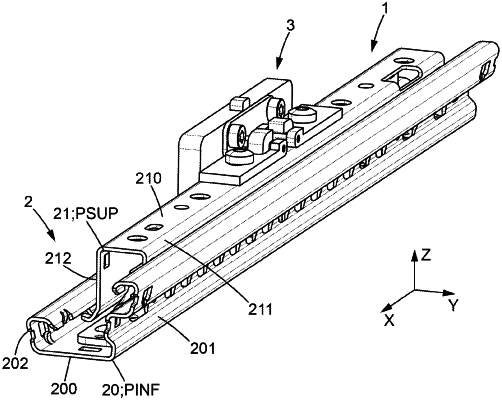| CPC B60N 2/08 (2013.01) | 12 Claims |

|
1. A slide rail locking system with continuous adjustment for a vehicle seat, comprising;
a slide rail comprising a first, lower, slide rail element configured to be fixed to a floor of the vehicle, and a second, upper, slide rail element configured to slide along the first slide rail element and
a system of locking by bracing, comprising:
a rail, extending in length along the slide rail, fixed relative to the first slide rail element, the rail presenting a first, upper, friction surface, and an opposite second, lower, friction surface,
a first blocking member and a second blocking member, mounted to be integral with the second slide rail element, with positions that are offset along a longitudinal axis of the rail, the first blocking member comprising a first wall and a facing second wall, configured to rub respectively along the first friction surface and the second friction surface of the rail, the second blocking member comprising a third wall and a facing fourth wall, configured to rub respectively along the first friction surface and the second friction surface of the rail,
an elastic member mounted between the first blocking member and the second blocking member, generating a return force configured to urge the first blocking member and the second blocking member towards each other, with generation of a first force between the first blocking member and a first brace integral with the second slide rail element, and generation of a second force between the second blocking member and a second brace integral with the second slide rail element,
and wherein the first force generated by the first brace on the first blocking member ensures bracing of the first blocking member on the rail, ensuring locking of the second slide rail element relative to the first slide rail element in a first sliding direction, by two reactions of the rail on the first blocking member, with a first reaction between the first upper friction surface of the rail and the first wall of the first blocking member on the one hand, and a second reaction between the second lower friction surface of the rail and the second wall of the first blocking member on the other hand,
and wherein the second force generated by the second brace on the second blocking member ensures bracing of the second blocking member on the rail, ensuring locking of the second slide rail element relative to the first slide rail element in a second sliding direction, by two reactions of the rail on the second blocking member, with a third reaction between the first upper friction surface of the rail and the third wall of the second blocking member on the one hand, and a fourth reaction between the second lower friction surface of the rail and the fourth wall of the second blocking member on the other hand,
an unlocking mechanism comprising a mobile unlocking member, configured to transition from a first position which allows bracing the first blocking member and second blocking member on the rail by the action of the elastic member, to a second position where the unlocking member separates the first blocking member and second blocking member against the return force of the elastic member, with release of the sliding of the second slide rail element relative to the first slide rail element.
|